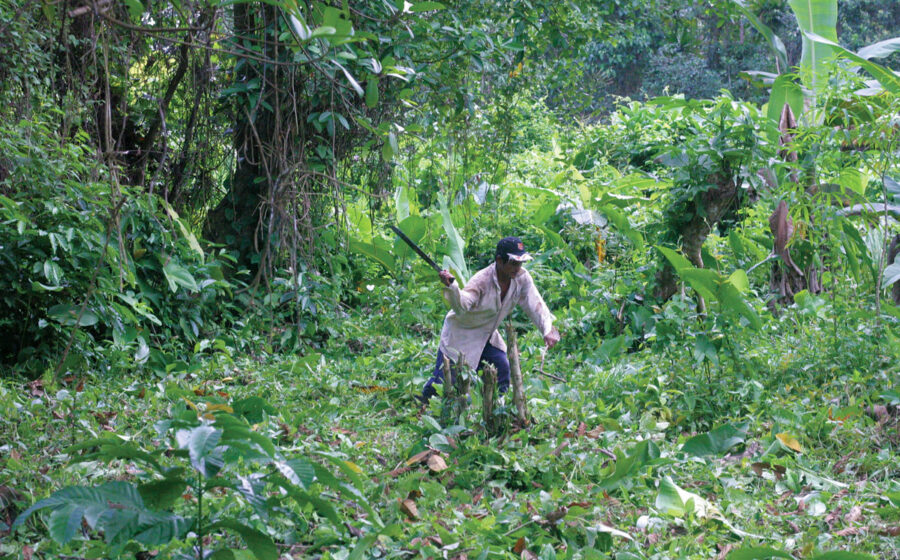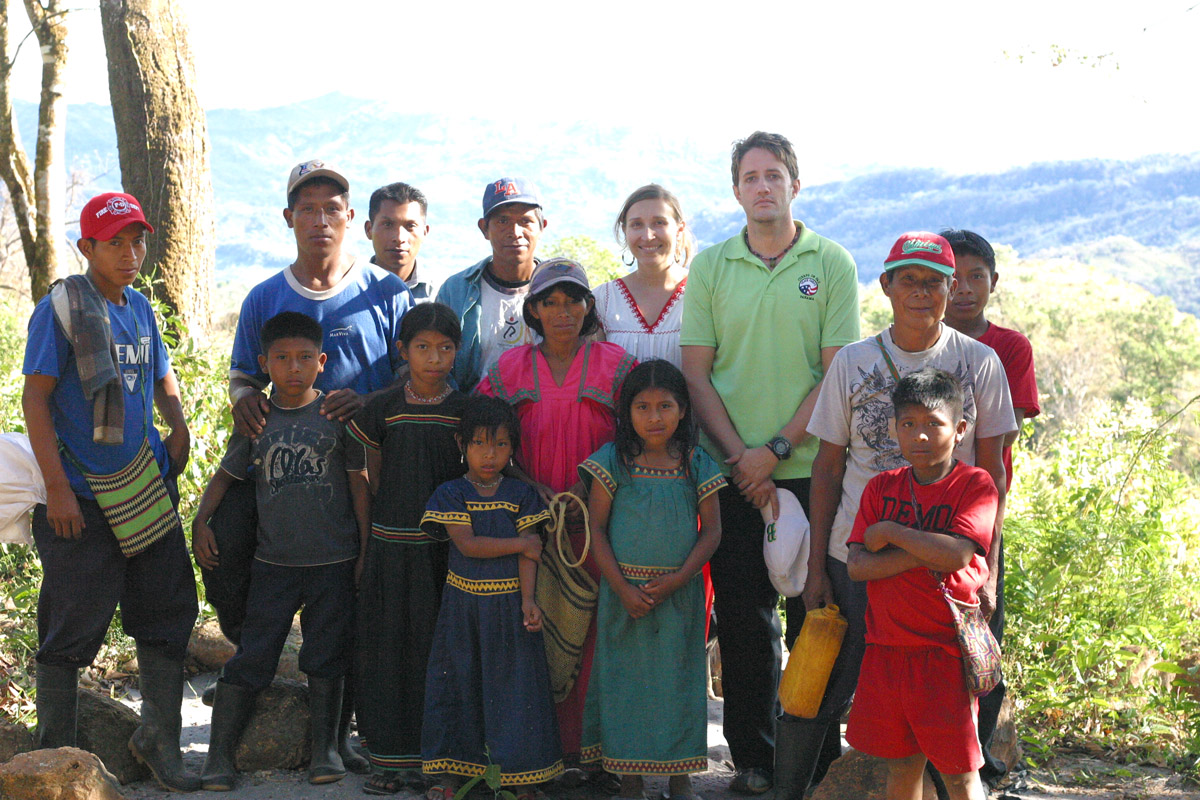[I]n her story “Long Laborers, Now Farmers,” Rachel Northrop introduces us to the Ngöbe, one of Panama’s native peoples. Ngöbe work as a migrant laborers on some of the best known coffee farms in that country, but are often not considered in the discussion about coffee production. Rachel’s story is a profound look at coffee laborers’ lives on the coffee farms and away from them.
Rachel has worked on coffee farms in Central America and traveled throughout coffee countries across Central and South America. Much of this effort was done while researching her book, When Coffee Speaks: Stories from and of Latin American Coffeepeople. The laborers who are often outside the conversation about ethical trade are a keen focus of her book. We wanted to find out why she jumped into this subject, how she discovered her subjects, and learn more about the people who make up such a large and critical part of coffee.
Fresh Cup: Your story includes a scene where you approach the village of Bahia Ballena on Panama’s Caribbean coast. It’s an isolated area, more jungle than village, and you can only go there with an invitation because its part of the Ngöbe-Buglé Comarca, which is roughly equivalent to a reservation in the United States. How did you end up on that boat?
Rachel Northrop: Like most forays into closed territories, that boat ride came to fruition through a long grapevine of referrals and a healthy dose of luck.
My journey into the coffee jungle began several months before boarding the “motor canoe.” I initially traveled to the Latin American coffee lands to live and work with families connected with coffee in order to compile When Coffee Speaks: Stories from and of Latin American Coffeepeople, a collection of interviews with people who work to make coffee possible.
I started my trek on a cow farm in Turrialba, Costa Rica, clearing weeds with a machete. I met a man from Chicago who had a cousin in the Peace Corps in Panama. That cousin (who I never actually met), put me in touch with Matt Tansey, a Peace Corps volunteer focused on sustainable coffee production in Bahia Ballena. Prior to the boat ride, I took a bus to the dusty Sixaola-Guabito border crossing between Costa Rica and Panama, where I met Matt. We then took two more buses and one pickup truck to the steamy fishing town of Chiriquí Grande, where we sat on a log in the sand, surrounded by tangled fishing nets, drinking Cokes from glass bottles (while the store owner eyed us like a hawk to make sure we returned the bottles) and waited for our boat driver to show up.
The Peace Corps has decades of history working in various regions of the Comarca, and most volunteers are far too busy working on various projects to coordinate homestays for self-funded research writers, but Matt and his community of coffee growers were as curious about my knowledge of coffee cultivation from working in Costa Rica as I was about their coastal Robusta production. It was a mutually beneficial arrangement.
Fresh Cup: That’s a long ways to go to meet people whose coffee rarely makes it to market and never outside Panama. In specialty coffee, the industry has made great strides toward better connections with farmers and trying to do right by them. But it’s not as if farmers are the end of the origin chain. What made you interested in discovering more about laborers? Do you think they’re considered enough when we think about ethical trade?
Rachel: No one likes to admit that there are problems we can’t solve. It gets uncomfortable when there are obstacles that can’t be surmounted by even well-intentioned people, businesses, and organizations with ample bankrolls.
I think that is the nature of the current relationship between farm workers and ethical trade in specialty coffee. Both ethical trade initiatives and the specialty coffee sector have decided to focus on areas where they can affect change—such as paying smallholders much deserved premiums for exemplary products—rather than try to tackle an issue like migrant labor.
Part of the reason that ethical trade is only beginning to tackle farm worker rights is that the answers to questions of where people come from and where they go are extremely complicated.
I’m always drawn to things that are right under our noses but which no one seems to be talking about. Even at origin, in the middle of harvest season when thousands of migrant workers—whether they were traveling from another country, another region, or just the other side of the mountain—flooded the cities of coffee region, no one really discussed their situation. I’m fascinated by logistics; I always want to know how things work behind the scenes.
There were whole populations of people who came, existed as harvesters for a brief period, and then literally disappeared into the night. Since that’s the status quo, it wasn’t cause for conversation. But I wanted to know where people came from before they showed up for harvest and where they went afterwards.
Part of the reason that ethical trade is only beginning to tackle farm worker rights is that the answers to questions of where people come from and where they go are extremely complicated. Some harvesters do have a stable home base and are landholders elsewhere, but some are true nomads with minimal possessions and no ties to a particular place. Those are the populations that even people with budgets and the best intentions can’t reach at this point.
That’s what makes the situation of the Ngöbes so fascinating; they are consistently nomadic, both culturally and as seasonal workers, but since they are also landholders there is particular potential for them to further develop their own agriculture.
Fresh Cup: Among the farm workers you met as you worked on your book, did they know what happened to the cherries they picked and processed? Often the coffee sold in origin countries is low-grade and most stories in Fresh Cup will explain the coffee is prepared roughly in pans of water. Do the workers at farms producing specialty coffee know that they’re the first part of a chain that leads to a highly regarded, highly refined, and maybe even hoity-toity product? Would that knowledge change anything for them?
Rachel: Workers who pick coffee on farms producing specialty coffee might not know exactly where the coffee they pick goes, but they do know that there is something special about it—only because they get paid more to pick it.
It’s actually pretty impressive how specialty travels directly from consumers back to workers. It’s usually tricky to trace coffee backwards and more illustrative to start at a farm and trace where that coffee goes, but with coffee from true single-origin farms—not from co-ops—specialty keeps its meaning from the coffee shop all the way back to the harvesters, who are compensated to work slowly and carefully rather than racing to pick more so that they can get paid more.
From true single-origin farms, specialty keeps its meaning from the coffee shop all the way back to the harvesters, who are compensated to work slowly and carefully rather than racing to pick more so that they can get paid more.
When farm owners really want harvesters to take the utmost care in selecting only the ripest of the ripe cherries, they have to abandon the system of paying pickers by volume picked and start paying them a flat rate for the day. Those are the type of harvester positions workers vie for, and they will come back to a farm year after year to have that kind of guaranteed wage. When roasters pay more for specialty coffee, farm owners can pay their workers more, but not all farms are in a position to pay daily wages to all their harvesters just in the name of pursing quality; some just pay an increased rate per unit picked.
Particularly in Panama, where there is not a co-op system and most landholders have a few lots of Gesha or other super-specialty varietals grown at prime elevations and microclimates, farm owners operate on a lot-by-lot basis. A crew of a few harvesters might be assigned to go over one lot of Gesha with a fine-tooth comb and be paid one rate for it, while the majority of harvesters pick the rest of the coffee—which is still specialty but not quite auction lot quality—for a set price per unit.
Most pickers don’t really understand the scope of the coffee industry and the distance coffee travels after they pick it. Workers assigned to a Gesha-picking crew are proud to be “promoted,” but they are only slowly beginning to conceptualize how far their work extends. Many workers I talked with didn’t know that there are places in the world that don’t grow coffee, and when I mentioned that coffee doesn’t grow in the continental US and that was why we came to Latin America to buy it, I could see light bulbs go off and puzzle pieces click into place. Several times workers would say, “So we grow something you can’t? We have something you don’t?” When I confirmed this, a smug look of satisfaction would flash across their faces, as though it were suddenly cool to be involved in coffee production: something the large, powerful, and mysteriously enigmatic US couldn’t do, and which it depended on them for.


















